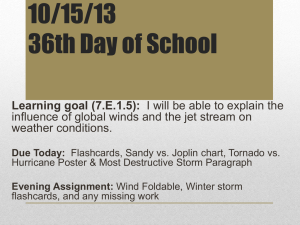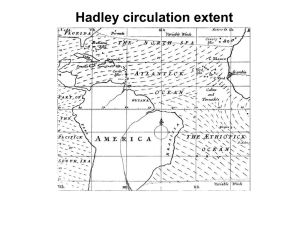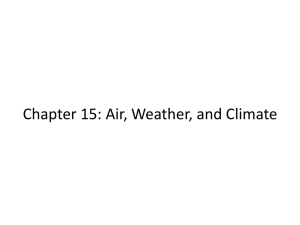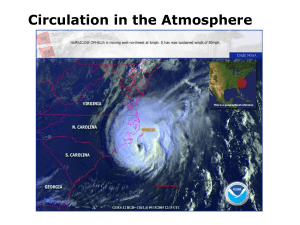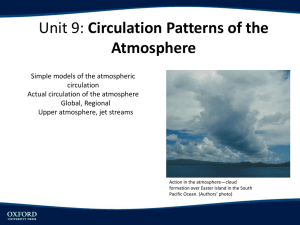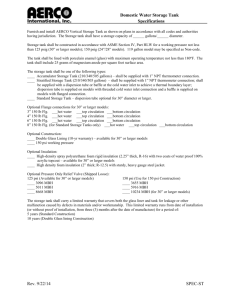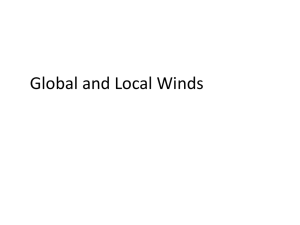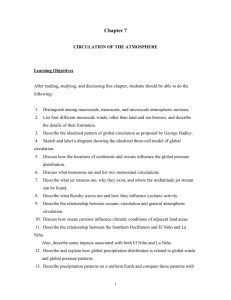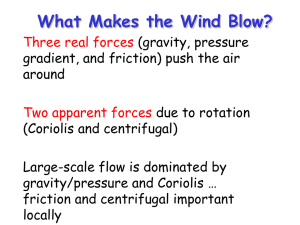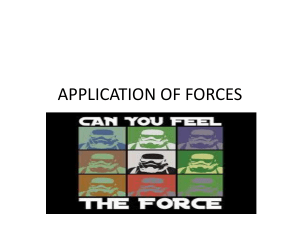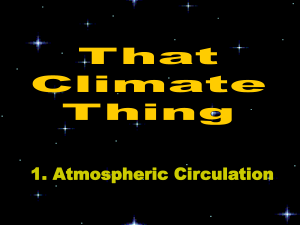General Circulation of the atmosphere
advertisement
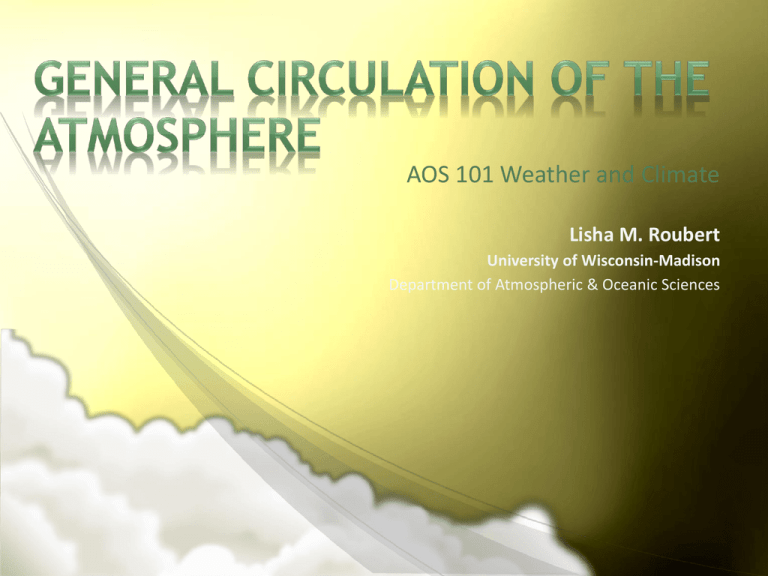
AOS 101 Weather and Climate Lisha M. Roubert University of Wisconsin-Madison Department of Atmospheric & Oceanic Sciences Today’s Lab • Today we will be using the tank lab to simulate the general circulation of the atmosphere. • By replicating certain atmospheric conditions in the tank we will have in this tank a system analogous to the atmosphere, which we can use to simulate atmospheric processes. Today’s Schedule • • • • Lecture on General Circulation. Explanation of the experiment. Instructions for Lab Report due next class. Experiment General Circulation • The worldwide system of winds, which transports warm air from the equator towards the higher latitudes, is called the general circulation of the atmosphere. • Since the pioneering studies of the atmosphere, scientists have tried to explain why surface winds blow from the east at subtropical latitudes and from the west in the mid latitudes, and why the trade winds are so steady compared to the westerlies. • Studies of the general circulation seek to describe the statistical properties of large scale atmospheric motion in a global context. General Circulation • The general circulation of air is broken up into a number of cells, the most common of which is called the Hadley cell. • Air heated at the equator rises and spreads out to the north and south. • The air cools and then sinks in the region of the subtropics. Some of this sinking air is then transported further poleward and the rest is transported back to the Tropics. • However, Earth is rotating so there will be some deflection of the air due to the coriolis force. Coriolis Force • The effect of the Coriolis force is an apparent deflection of the path of an object that moves within a rotating coordinate system. • The object does not actually deviate from its path, but it appears to do so because of the motion of the coordinate system. Coriolis Force • Due to coriolis force an air mass will appear to be deflected because the Earth underneath the air mass is rotating. Coriolis Force, Easterlies and Westerlies • Coriolis force is zero at the equator and gets stronger as we move towards the higher latitudes • In the Northern Hemisphere air deflects to the right. In the Southern Hemisphere air deflects to the left. • The Coriolis force is the reason why the upper level, poleward traveling air (wind) is westerly; whereas the equatorward traveling, surface winds are easterly. In the tropics, these easterlies are known as the trade winds. Why are the Westerlies faster than the Easterlies? • To answer this question we first need to know about momentum. There are two types of momentum: ▫ Linear Momentum-If an object is moving in a straight line it has: Momentum=m × v m=mass v=velocity Why are the Westerlies faster than the Easterlies? • Angular momentum: An object that is rotating has an angular momentum: Ang. M=m × v × r r=radius or distance from the axis of rotation • A rotating undisturbed object will conserve its angular momentum. This means: Ang. M= m × v × r= constant • When the distance from the rotation axis (r) decreases, the rotation velocity (v) increases to conserve angular momentum. Why are the Westerlies faster than the Easterlies? • The air in the westerly winds is closer to Earth’s axis of rotation than the air at the equator so to conserve angular momentum it’s velocity will increase and we will have fast moving air from west to east. General Circulation Tank Lab Experiment Poles • Today we will be using the tank lab to simulate the circulation of the atmosphere. Specifically to simulate the Hadley Cell. • The tank will be rotating slowly-less than 2 revolutions per minute. • Ice is set up in the middle so that we have a temperature gradient that will drive motion. • Dye will be used to observe fluid motion and permanganate will be used as a tracer. Lab Report-Due next class • Title • Objective: describe the purpose of the lab • Hypothesis: use your knowledge to make a prediction of what is going to happen. • Methodology: describe the set up of the lab and explain the steps performed in the experiment • Results: what happened in the experiment, what did you see, etc • Discussion: discuss what happened in the tank relating it to what happens in the circulation of the atmosphere. (physical explanation) • Conclusion: Summarize the findings of the lab and give your opinion about the lab
